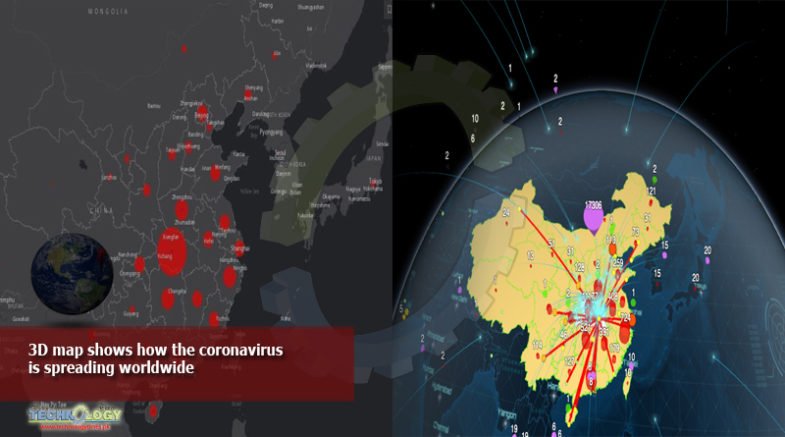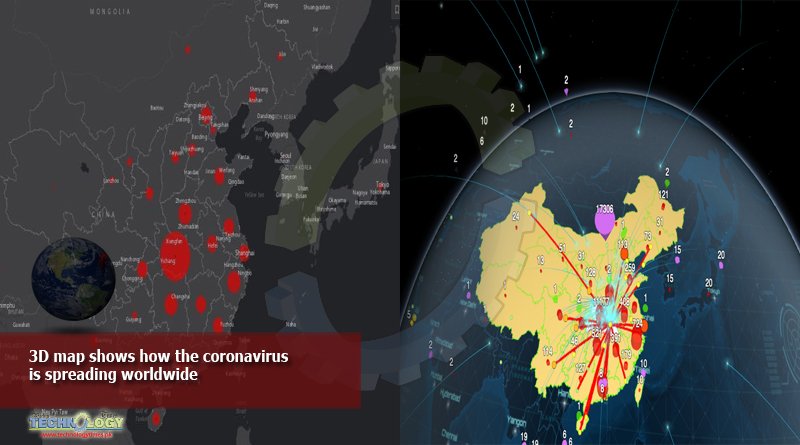A UN aviation agency uses GIS software to track transmission lines while 20 US airports set up screening centers.

Turquoise arcs travel around the globe in a 3D map that illustrates the spread of the 2019-nCoV (commonly referred to as coronavirus) strain around the world.
A United Nations aviation agency built the 3DFX Dispersion map, which shows the movement of the virus around the world via air traffic routes from Wuhan, China.
The geographic information system (GIS) map displays multiple layers of data, including deaths, confirmed cases, and cases by country. (A geographic information system gathers, manages, and analyzes many types of data and organizes it into visualizations using maps and 3D scenes.)
The 3D map has two animations. The play button in the lower gray bar makes the globe rotate. The other continuous animation links the first wave cases of the virus in countries around the world back to the Wuhan province. Turquoise arcs start in Central America, Australia, and Asia and move around the globe back to Wuhan. These arcs illustrate the first wave of cases inside China and originating from China. Another layer of the map shows the second wave of cases.
From the layer list, users also can see affected regions following the second wave and airport information. The legend button in the upper gray menu bar explains the symbols on the map. The layer list from the menu shows the data sets that can be displayed on the map.
The data for the confirmed cases, deaths, and recovered patients are from WHO, CDC, and NHC.
The map was built by the ICAO GIS for Organization, a group which manages a collection of GIS maps for the International Civil Aviation Organization (ICAO), a United Nations agency that sets standards and regulations necessary for aviation safety, security, efficiency, capacity, and environmental protection. The ICAO has 193 member states, including the United States and the United Kingdom.
ICAO has a branch that focuses on public health, the Collaborative Arrangement for the Prevention and Management of Public Health Events in Civil Aviation (CAPSCA). CAPSCA advises members on how to address the coronavirus outbreak.
The risk of contracting the coronovirus is low in the US. According to the latest report from the WHO, the majority of cases are due to exposure in Wuhan or elsewhere in China with few cases “locally acquired” in other countries. The flu season has been a much bigger problem this year with 19 million people catching the illness and 10,000 dying from it.
Impact on business
However, that doesn’t mean that companies in the US and throughout the world aren’t responding to the virus. Tech firms have started to take action in response to the outbreak. Apple and Google have begun closing offices and stores and limiting travel to China.
Many airlines are either limiting or canceling China flights including American, Air Canada, British Airways, Cathay Pacific, Delta, United Airlines, Lufthansa, Austrian, Swiss, and Finnair. United Airlines has stopped flights between its hubs and Beijing, Chengdu, and Shanghai from Feb. 6 through March 28.
The Centers for Disease Control are screening passengers from Wuhan at 20 airports around the country. This includes answering questions about symptoms as well as travel and contacts while in Wuhan. Passengers will also have their temperatures taken.
Here are the 20 airports where travelers will undergo additional screening:
- Los Angeles International
- John F. Kennedy International
- O’Hare International
- San Francisco International
- Atlanta’s Hartsfield-Jackson
- Anchorage Ted Stevens International
- Boston Logan International
- Dallas-Fort Worth International
- Detroit Metropolitan
- El Paso International
- Honolulu International
- Houston George Bush International
- Miami International
- Minneapolis-St. Paul International
- Newark Liberty International
- Philadelphia International
- Puerto Rico’s San Juan International
- San Diego International
- Seattle-Tacoma International
- Washington Dulles International
